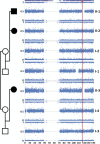Mutations in COL27A1 cause Steel syndrome and suggest a founder mutation effect in the Puerto Rican population
- PMID: 24986830
- PMCID: PMC4326704
- DOI: 10.1038/ejhg.2014.107
Mutations in COL27A1 cause Steel syndrome and suggest a founder mutation effect in the Puerto Rican population
Abstract
Osteochondrodysplasias represent a large group of developmental structural disorders that can be caused by mutations in a variety of genes responsible for chondrocyte development, differentiation, mineralization and early ossification. The application of whole-exome sequencing to disorders apparently segregating as Mendelian traits has proven to be an effective approach to disease gene identification for conditions with unknown molecular etiology. We identified a homozygous missense variant p.(Gly697Arg) in COL27A1, in a family with Steel syndrome and no consanguinity. Interestingly, the identified variant seems to have arisen as a founder mutation in the Puerto Rican population.
Figures




References
-
- Steel HH, Piston RW, Clancy M, Betz RR. A syndrome of dislocated hips and radial heads, carpal coalition, and short stature in Puerto Rican children. J Bone Joint Surg Am. 1993;75:259–264. - PubMed
-
- Flynn JM, Ramirez N, Betz R, et al. Steel syndrome: dislocated hips and radial heads, carpal coalition, scoliosis, short stature, and characteristic facial features. J Pediatr Orthop. 2010;30:282–288. - PubMed
Publication types
MeSH terms
Substances
Grants and funding
LinkOut - more resources
Full Text Sources
Other Literature Sources
Molecular Biology Databases

